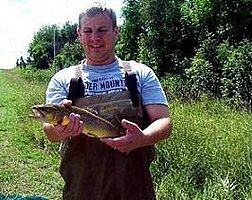The life history of Hexagenia limbata (Serville) (Ephemeroptera:Ephemeridae) in North Dakota and Minnesota streams.

Ara Anderson’s research interests include community ecology, hydrology, and freshwater ecology, with emphasis on macroinvertebrates, fish, and streams. Ara received his Associate of Arts (2002) from Central Lakes College in Brainerd, MN before transferring to North Dakota State University were he completed a Bachelors of Science in Zoology (2004) with an emphasis on fisheries, wildlife, ecology and animal behavior. As a undergrad, Ara participated in a research project examining thermal patterns in the spring-fed Straight River near Osage, MN. He is currently working on a Masters degree in Zoology under the direction of Dr. Malcolm Butler. His thesis research is an examination of life history variation in the burrowing mayfly Hexagenia limbata in small streams of western Minnesota and eastern North Dakota.
Email: Ara.Anderson@ndsu.edu
Fellow: Ara Anderson, Department of Biological Sciences, NDSU
Advisor: Malcolm Butler, Professor, Department of Biological Sciences, NDSU
Matching Support: NDSU Department of Biological Sciences, Straight River Trust Fund of MN Trout Unlimited
Degree Progress: Masters expected in May 2007.
The life history of Hexagenia limbata (Serville) (Ephemeroptera:Ephemeridae) in North Dakota and Minnesota streams.
Project objectives:
My research will characterize certain aspects of the life history of Hexagenia limbata (Hex) in small streams of the upper Midwest by comparing populations in eastern North Dakota and west-central Minnesota. I hope to determine whether variables like voltinism, size, fecundity, and sexual dimorphism vary among my study populations, or differ from life history patterns known for well-studied Hex populations in lentic habitats or large rivers like the Upper Mississippi. Causal mechanisms that may be altering Hex life history will be evaluated. This life history information should enhance the use of H. limbata as a biological indicator.
Progress:
The primary goal of this study has been to determine life history characteristics of H. limbata (Hex) nymphs within the Straight and Shell Rivers, MN using data collected from 2004 through 2006, and to establish causal mechanisms if life history variation is demonstrated between or within these two streams. Hex nymphs also will be collected in 2006 from other streams within Becker, Beltrami, Hubbard, Cass and Wadena counties, Minnesota; and from multiple sites in the Sheyenne River (near Sheyenne, Pekin, McVille, Fort Ransom, and Cooperstown), the Cannonball River (near Breien), and the James River (near Dickey, and LaMoure) in North Dakota. Hex has been collected previously at the ND sites by the ND Department of Health (Neil Haugerud, personal communication). Hex collected in 2006 will provide a regional context within which to place the more extensive data set from the Straight and Shell Rivers, as well as provide additional data concerning life history patterns and controls. The current research was initiated during the summer of 2005, however nymphs have been collected since 2004 from the Straight River. Nymphs were collected during 2005 approximately monthly from April through October. All nymphs collected to date have had gender determined and head width measured. Fecundity, densities, and sex ratios have been calculated for each date/site collected. Production will be calculated. Data analysis has been initiated but is not yet sufficient to report any results.
Significance:
Ultimately, understanding how Hex life history responds to alterations in the lotic environment may allow Hex to serve as the proverbial “canary in the coal mine” to quickly detect the presence of pollution and eutrophication and allow remedial action to be taken.
Related Publications and Presentations:
Presentations (Chronological Order):
“Flowing Water: An Introduction to Lotic Ecology” Guest Lecture. NDSU Department of
Biological Sciences Zoology 470/670: Limnology. Fargo, ND. October 25, 2005.
“Scale-Dependent Thermal Patterns in a Groundwater-Influenced Stream” Poster
Presentation. Coauthored by Malcolm G. Butler. North American Benthological Society (NABS) Joint Assembly. New Orleans, LA. May 25, 2005 .
“ Thermal Patterns in the Straight River: A Ground Water Influenced Stream” Poster
Presentation. Coauthored by Malcolm G. Butler. Northern Plains Biological Symposium, Fargo, ND. March 4, 2005.
“Fish Community Structure in Disturbed and Undisturbed Stream Reaches” Oral
Presentation. Coauthored by Ryan Anderson. NDSU Zoology 477/677: Wildlife and Fisheries Management Techniques. Fargo, ND. May 6, 2004.
“Non-Target Impacts of Classical Biological Control” Oral Presentation. NDSU
Department of Biological Sciences Senior Seminar. Fargo, ND. May 1, 2004.
Reports:
Anderson, A.D. and Butler, M.G. 2005. Investigations on aquatic invertebrates in the Straight River (Becker/Hubbard Co., MN) with emphasis on the burrowing mayfly Hexagenia limbata. Report to the Straight River Trust Committee 13 pgs.
Anderson, A.D. and Butler, M.G. 2005. Thermal patterns in the Straight River: a groundwater-influenced stream. Report to the Straight River Trust Committee 19 pgs.

Melcolm Butler
Biological Sciences
Office: Research 2, Room 214B
Phone: 701-231-7398
Email: malcolm.butler@ndsu.edu


